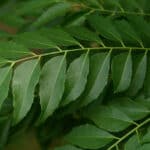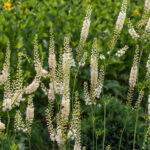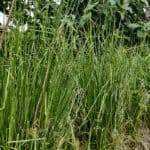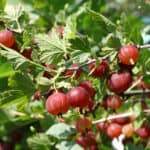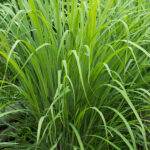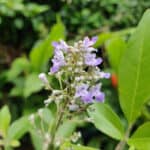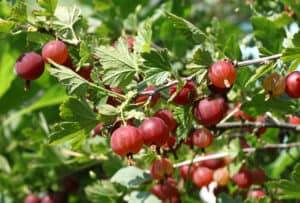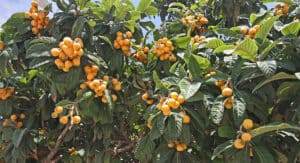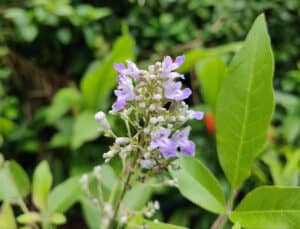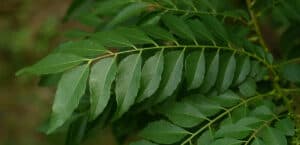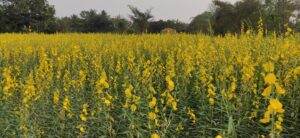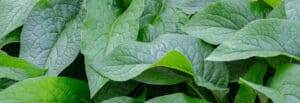A flower of the sun, a light to lead one out of the dark, St. John’s Wort is a medicinal plant revered for its ability to not only heal on the physical level but also the psycho-spiritual levels.
While its claim to fame is its “antidepressant” qualities, there is much more to learn and appreciate about this remarkable herb than that alone.
Yes, it certainly helps with depression, but just as depression is complex with various nuances, so is the medicine of St. John’s Wort.
In this growing guide, I’ll cover how you can bring St. John’s Wort into your garden or permaculture landscape, as well as its rich history, how to harvest it for medicine, and its multifaceted medicinal properties.
Plant Overview
St.John’s Wort (Hypericum perforatum) is an herbaceous perennial belonging to the Hypericaceae or St. John’s Wort family.
Native to Eurasia and North Africa, St. John’s Wort has naturalized throughout North America.
It prefers open meadows, sunny south-facing slopes, forest edges, and prairies.
While there are several Hypericum species across North America, most of which are native, they are not medicinally interchangeable with St. John’s wort.
So, if you wish to grow St. John’s wort for medicinal purposes, you’ll want to grow the official medicinal species, Hypericum perforatum.
The growth habit of St. John’s wort depends on its environment.
In areas with full sun and rich soil, it can reach 3 feet tall with branching stems.
In shadier locations, it grows erect to about 1 to 2 feet tall with fewer branching stems and fewer flowers.
The 5-petal flowers are golden yellow with noticeable yellow stamen.
The petals are peppered with black dots around the edges.
The opposite leaves are sessile, 1-2 inches long, oblong, or linear with a rounded tip.
The easiest way to distinguish St. John’s wort is to hold one of its leaves to the sun.
The leaves have many translucent dots, giving them a perforated appearance, hence St. John’s wort’s species name, perforatum.
This characteristic relates to the Doctrine of Signatures for this plant, which is the practice of noticing patterns (how it grows, where it grows, and how it tastes) to distinguish the plant’s medicinal properties.
For St. John’s wort, the perforated leaves symbolize its ability to heal puncture wounds.
I’ll explain this property in more detail under St. John’s wort’s medicinal uses.
History of St. John’s Wort
St. John’s wort’s common name is associated with St. John’s Day, which occurs just after the summer solstice, as this is when St. John’s wort starts to bloom.
Traditionally, St. Johns’s wort is harvested on the Summer Solstice or the day before St. John’s Day.
The herb was hung over doorways and windows in honor of St. John the Baptist and to serve as protection against “evil forces.”
One of the reasons it was seen as a spiritual herb by the catholic church is because when looking down at it from above, it grows in the shape of a cross.
Those are the Christian/catholic roots of St. John’s wort, but it has long held a spiritual significance within the pagan tradition as well.
Matthew Wood notes in the Book of Herbal Wisdom, “During the Middle Ages, St. John’s wort was used to protect people against demons, witchcraft, and lightning.”
Midsummer Eve, when St. John’s wort starts to flower, is also associated with the “Little People” or faeries.
During this time, the veils are thin, and the “little people” are said to traverse between human and faerie lands.
St. John’s wort is not only seen as an herb associated with the magic and luck of the faeries but as a protection against “malevolent faeries” as well.
Other than the magical and spiritual lore around St. John’s wort, it has a long tradition of use as a wound healer and “blood cleanser.” It was used to lift the spirits and even to treat people overtaken by dark forces, such as demons or other malevolent beings.
Nowadays, we acknowledge those “dark forces” as depression, anxiety, and PTSD.
How to Grow and Care for St. John’s Wort
St. John’s wort is an easy plant to grow once established if given its preferred conditions.
You’ll have to nurture the seedlings; taking care of them can be somewhat of a challenge, but once they mature, they become hardy perennials that will tolerate drought and extreme weather.
It can grow in zones 3-9 and prefers full sun to part shade in well-draining, fertile to depleted soil.
As a “weed,” it can grow in various soil conditions, including sandy loose soil, and compact, rocky soil.
It will tolerate acidic to slightly alkaline pH levels.
The most important requirement for St. John’s wort is well-draining soil, as this drought-tolerant herb doesn’t like its feet wet during the growing season.
I specifically say during the “growing season” because St. John’s wort does quite well in western Oregon, where the soil is so damp during the winter and spring that it’s like a sponge.
Yet, St. John’s wort comes up happy and ready to flourish each year, just as the rains recede and dry warmth descends.
Considering that St. John’s wort is a perennial, the roots must not mind damp conditions during the winter when they’re dormant.
While this magical herb can grow in part shade just fine, it truly is a “plant of the sun” and needs at least a few hours of full sun to bloom and thrive.
In the north, it’s best to plant St. John’s wort in full sun, while in hotter climates in the south, it will appreciate some afternoon shade.
St. John’s wort will not flower in the first season but should produce blooms the following year if given its preferred conditions.
It does tend to self-sow, so if you notice more St. John’s wort coming up, you can easily pull those seedlings up before they flower.
Propagation
St. John’s wort can be propagated by seed, root division, layering, or cutting.
To start it from seed, Richo Cech of Strictly Medicinal Seeds recommends starting the seeds in spring and shallowly sow them in a sandy soil mixture.
Keep evenly moist and in the light until germination, which takes about 5 to 21 days.
The optimal germination temperature for St. John’s wort is around 65 to 70 degrees.
Herbalist and gardener Juliet Blankespoor with the Chestnut School of Herbal Medicine recommends a two-month cold-moist stratification period for the seeds.
You can achieve this cold stratification period by sowing the seeds in early spring or by mixing them with damp sand and placing them in a fridge.
Once the seedlings emerge and grow a couple of pairs of true leaves, transplant or thin to about 1 ½ – 2 feet apart.
Divide the roots in fall or early spring.
Cut back any vegetation growth if present to help establish the roots.
For stem cuttings, it’s best to select healthy semi-ripe cuttings from large, established plants.
Fertilization
While rich, fertile soil will create large and happy plants, fertilization isn’t necessary for St. John’s wort.
Many herbalists believe (myself included) that a mildly stressed herb will produce more potent medicine.
In this way, it’s best to mimic the natural, disturbed environment St. John’s wort does so well in if you wish to harvest it for medicine.
That said, if your St. John’s wort starts to look sad and you feel it can benefit from more nutrients, you can side-dress the established plants with organic compost.
Pests and Diseases
In general, St. John’s wort is resistant to pests and diseases.
However, one pest that can be a problem for St. John’s wort is the Klamathweed beetle (Chrysolina quadrigemina).
Klamathweed is another common name for H.
perforatum, and in the 1940s, this exotic beetle was purposely introduced to California to manage the growing St. John’s wort population on the West Coast.
St. John’s wort is toxic to grazing livestock, as it causes photosensitivity and an increased risk of death in cattle due to sunburn.
Because St. John’s wort grows in disturbed areas, it spread quickly throughout cattle ranges.
To address this problem, the government introduced the Klamathbeetle, which has now spread throughout the United States, over to the East Coast.
The introduction was a success as the beetle significantly reduced the St. John’s wort population in California.
I noticed this beetle on St. John’s wort plants in Oregon but haven’t noticed them as much in Michigan.
Where I lived in the Cascade mountains of Oregon, there was an abundant St. John’s wort population, so it seems (by simple observation) that the beetle helps control the population but does not completely decimate it, nor did they seem to affect my ability to gain a substantial St. John’s wort harvest.
Invasive Status
It’s important to note that St. John’s wort is considered a weedy, invasive plant, and some states have banned the sale of its seeds.
These states include California, Colorado, Montana, South Dakota, and Washington.
It’s interesting to note that these states have arid, dry climates (specifically Eastern Washington in this case) in which St. John’s wort thrives.
Considering this, it’s safe to assume that it is less likely to spread in more humid climates.
If you live in an area where St. John’s wort is prolific, it’s better to wild harvest this herb rather than bring it into your garden.
Chances are you might already have it growing in your garden.
If so, this growing guide gives you the information you need to confidently harvest and utilize its medicine.
Plus, the benefit of “weedy” medicinals is that you don’t have to worry about harvesting too much of them.
Many native medicinal plants are not as prolific and require care and attention to not overharvest them.
That isn’t the case with St. John’s wort, so it’s a wonderful plant to gain a sizable harvest from if it’s abundant and widespread in your area.
Harvesting
The flowers and buds are the main part used, but the whole aerial parts of St. John’s wort can be harvested when it’s in flower.
Traditionally, St. John’s wort is harvested on or around the summer solstice, as that is when it starts to bloom.
Lucky for us spontaneous or more busy folks, St. John’s wort flowers throughout the summer, from June to September.
When observing St. John’s wort in flower, you’ll see that the inflorescence is atop small branched stems.
I find the best harvest is to snip the base of a flowering stem, one that holds vibrant opened flowers as well as many unopened buds.
I try to harvest as little of the stems as possible, as I find it cumbersome later on when the dried plant is in a jar.
If you harvest a lot of stems with the flowers, the stems take up a lot of room in the jar while the rest of the more valuable plant material falls to the bottom.
Retrieving the precious dried flowers, buds, and leaves amongst the mess of stems can be a bit of a challenge, so save yourself the difficulty by avoiding long stems.
While it will increase your harvesting time, I promise you’ll be better off with a rich harvest of the desirable flowers and buds.
The buds are believed to be the most medicinal part of the plant, as they have the most amount of active constitutions, especially hypericin.
You can see this yourself by squeezing a bud in your fingers.
It will release a dark red, purplish oil – this is the most desirable medicinal part of St. John’s wort, and this is why fresh St. John’s wort yields dark red infused oils and tinctures.
Medicinal Uses
Parts Used: flowers, flower buds, and leaves
Medicinal Actions:
- Nervine (sedative & trophorestorative)
- Bitter
- Hepatoprotective
- Astringent/Vulnerary
- Anodyne
- Antimicrobial
Herbal Preparations: Infusion, tincture, infused oil, salve, compress, and capsule
St. John’s wort is most known for being an “anti-depressant.” While there is truth to this, we cannot assume that it will immediately take one’s depression away or will work for everyone who has depression.
Herbs are complex and work in a significantly different way than pharmaceutical drugs.
Furthermore, by pigeonholing St. John’s wort as an “antidepressant herb,” we can lose sight of all the other wondrous ways it can heal the body.
To understand the medicine of St. John’s wort, we must look at it holistically and examine all the different ways it affects the human organism.
Because St. John’s wort is best known as an anti-depressant, let’s dive into why St. John’s wort helps with depression (and sometimes doesn’t).
Then, I’ll cover its other equally important medicinal qualities.
St. John’s Wort and Depression
St. John’s wort is beneficial for depression through its affinity for the nervous system.
It is a nervine sedative and trophorestorative, which means it can gently sedate tense nerves and bring restorative healing to the nervous system as a whole.
When someone is suffering from depression, they often have a depleted or worn-out nervous system due to long periods of tension, stress, anxiety, trauma, and or insomnia.
In this way, St. John’s wort can help bring nourishment and healing to a depleted nervous system.
As a bitter tonic and hepatoprotective, St. John’s wort has a strong influence on the liver and digestion as a whole.
It can help bring the liver into greater function, thus improving the liver’s ability to process toxins.
Interestingly, depression can have a direct link to stagnation in the liver.
Most often, this type of depression is associated with anger, frustration, and irritability.
The body isn’t able to move toxins sufficiently out of the body, resulting in feelings of being ‘stuck’ and stagnant.
Because St. John’s wort strengthens the liver, gut, and digestion as a whole, it can help the body detox built-up waste products and move them out of the body.
This ability, along with its strong effect on the nervous system, is beneficial for folks struggling with a worn-out nervous system and sluggish digestion – which accumulates into depression.
From this, we can also see that St. John’s wort isn’t a ‘one size fits all’ for depression.
Rather, it’s pretty specific for depression associated with weakened digestion and irritation/anger.
Moreover, its energetic qualities support depressed states that feel dark, unmotivated, and sluggish.
It is often used in formulas for SAD (seasonal affective disorder) for its ability to uplift the spirits and show us the sunlight and warmth that is always within us.
Depression and melancholy are complex and can be a result of various causes.
Simply taking St. John’s wort every day won’t be enough to cure you of depression.
For holistic wellness and to truly get to the root of the issue, one must go beyond using herbal medicine alone in their treatment.
Other areas of life that should be addressed include diet, habits, thought patterns, spirituality, community, sleep, and trauma.
Using herbal medicine in conjunction with therapy, nutritional advice, lifestyle adjustments, spiritual healing, and whatever avenues best serve the individual is the best way to reach true and sustainable health.
Nerve Pain
St. John Wort not only has a strong affinity for the nervous system as a whole but also for individual nerves.
As an anodyne (pain-relieving herb), St. John’s wort is specific for nerve pain.
Through its trophorestorative effect on the nerves, St. John’s wort also heals damaged nerves.
Sajah Popham of the School of Evolutionary Herbalism writes, “Anytime there is sharp shooting inflamed nerve pain, always consider St. John’s Wort as it is highly unique in this way and one of our only remedies with this specific an [cis] action on nerve related pain.”
In this, St. John’s Wort is a reliable remedy for conditions including sciatica, neuralgia, pinched nerves, spinal cord injuries, shingles, and tooth pain.
It can be used topically and internally for these conditions.
Improved Digestive and Liver Function
One of the main avenues St. John’s wort brings healing to the body, other than the nervous system, is the liver and digestive system.
As mentioned above, St. John’s wort has a strong influence on the liver.
St. John’s wort not only helps strengthen the liver and bring it into greater function, but it also serves as a hepaprotective, which means it protects the liver from oxidative stress, inflammation, and damage from poisons.
This unique herb has such a powerful effect on the liver’s detoxification pathways that it impacts the metabolization of various compounds in the liver, such as pharmaceutical medications.
This means that when medication is absorbed and assimilated into the bloodstream by the liver, St. John’s wort ‘blocks’ its absorption, thus reducing its activity.
This use of St. John’s wort is helpful for an underperforming, weak, and struggling liver that can’t process toxins properly.
This use isn’t helpful, however, when you’re using medications such as contraceptives, among many others.
On the other hand, St. John’s wort can increase the effect of certain medications, such as monoamine oxidase inhibitors (MAOIs) and selective serotonin reuptake inhibitors (SSRIs).
This paradox is due to the constituent hyperforin, which inhibits the reabsorption of serotonin and the enzyme monoamine oxidase (MAO).
In other words, It increases these medications because of its natural ability to do the same thing as them.
However, these studies are on a single isolated constituent, and they do not reflect the mechanisms of action of the whole plant.
When you separate a part from the whole, it will not behave the same way as when it is still part of the whole.
Nonetheless, it is still wise to avoid the use of St. John’s wort with antidepressants such as SSRIs and MAOIs.
Antimicrobial Uses
The use of St. John’s wort as an antimicrobial isn’t well known, and I would say most herbalists don’t tend to use St. John’s wort in this way.
That said, scientific research shows that St. John’s wort possesses anti-viral, anti-fungal, anti-bacterial, and anti-yeast properties.
Studies on the main active constitutions of St. John’s wort, hypericin and hyperforin, showed them effective against various pathogenic strains, including Staphylococcus aureus.
The research goes on to say,
“.
.
. hypericin have shown activities against pathogenic fungi and yeasts such as Trichophyton rubrum, Fusarium oxysporum, Microsporum canis, Pichia fermentans, Exophiala dermatitidis, Kluyveromyces marxianus, Candida albicans, and Saccharomyces cerevisiae.
Moreover, studies have reported antiparasitic effects for hypericin and hyperforin against malaria and leishmaniosis parasites.
Hypericin is also effective against viral protease that is well known for its activity against several viruses namely, herpes simplex, bronchitis, influenza A, and human immune.”
While this compelling research is certainly exciting, these results are from studies on isolated and concentrated hypericin extractions, so these findings may not apply to the home use of St. John’s wort.
It still possesses these antimicrobial properties, though perhaps not as strongly as shown in the study since most home herbalists aren’t extracting active constituents and separating them from the whole.
Topical Uses
Along with its myriad of internal uses, St. John’s wort is a wonderful ally to have on hand for topical ailments.
It can be used as a salve, balm, soak, or compress for burns, cuts, bruises, sprains, and scrapes.
Interestingly, it is one of the best topical wound healers for deep puncture wounds.
The affinity for puncture wounds is found in the signature of the leaves, which have several “holes” that are clear to see when held towards the sun.
St. John’s wort heals from the “bottom-up,” which means it helps knit tissues back together at the base of the wound rather than the surface.
This is critical, as some wound healers, such as comfrey, knit tissues together at the surface, which can lock in infection.
St. John’s wort, combined with Calendula, is perfect for addressing deeper wounds in the form of a compress.
Furthermore, its antimicrobial properties help to disinfect the wound.
St. John’s wort is also highly beneficial for sunburns, which is paradoxical since St. John’s wort can also increase photosensitivity.
Nonetheless, it is one of the best herbal allies for healing sunburns.
Again, it combines beautifully with calendula for this purpose.
Safety and Contraindications
St. John’s wort can interfere with several medications.
Because of this, it’s important to speak with a qualified herbalist or trust healthcare professional before taking St. John’s wort if you are on any medications.
The types of medications St. John’s wort interacts with, but is not limited to, include:
- Antidepressants (specifically SSRIs and MAOIs)
- Anti-epileptic drugs
- Antiretroviral agents
- Anti-coagulants
- Calcium channel blockers (for high blood pressure)
- Contraceptives
- Chemotherapy
- Cyclosporine
- Immunosuppressants
- Macrolide antibiotic
- Non-sedating antihistamines
Moreover, St. John’s wort increases photosensitivity, so it is contraindicated for use when exposed to direct sunlight for prolonged periods of time.



















